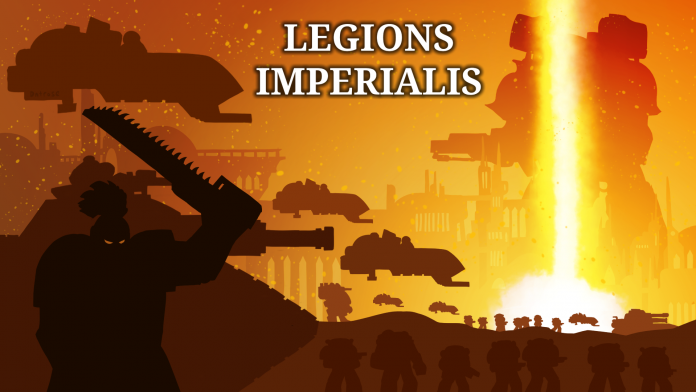The Devastation of Tallarn is the new book for Legions Imperialis. It follows a similar format to The Great Slaughter, with an extensive background section, campaign rules, scenarios and new units for both factions. Thanks Games Workshop for providing us with a copy of the book to review.
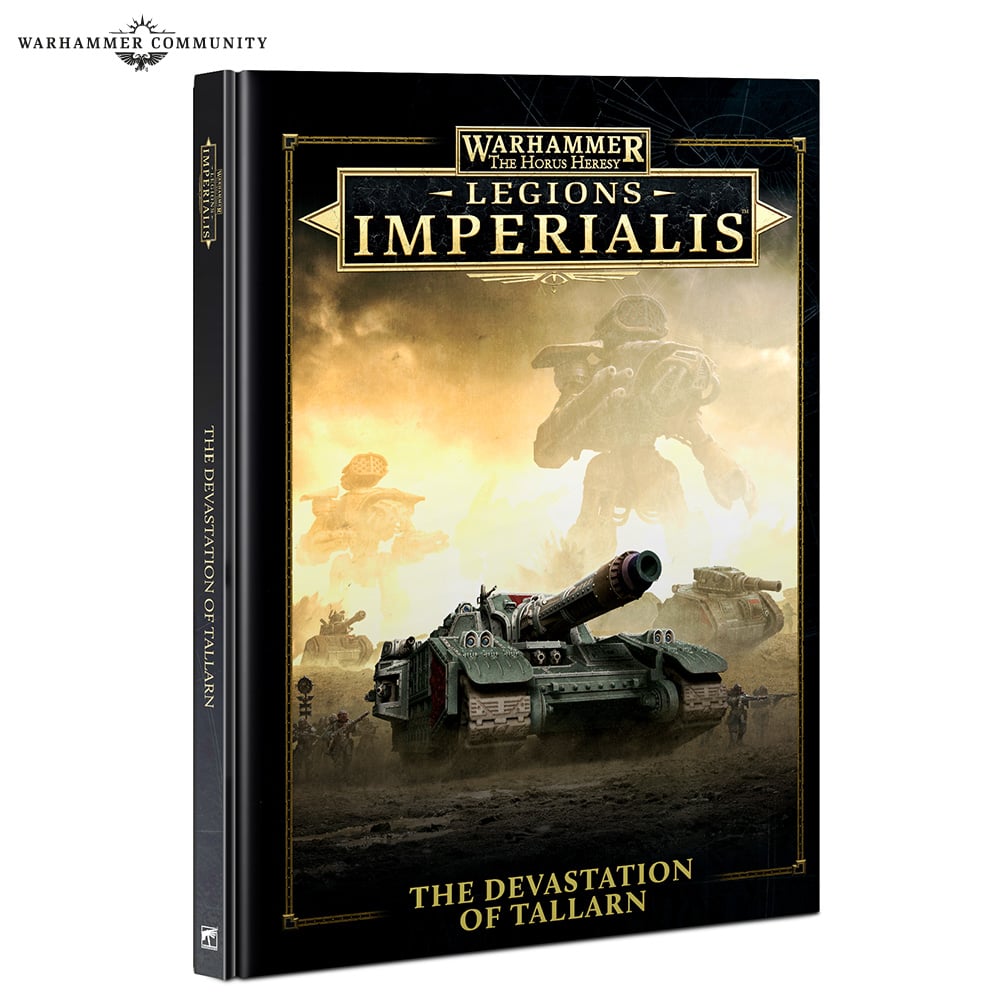
Background
I’ll be brief in covering what’s actually a long, detailed section of background. It does a good job of illustrating the horror of this particular conflict, in my opinion. Well worth reading rather than skipping through to the new units.
Tallarn is a pretty nice place at the start of the book. It was an important mustering world through the great crusade but also the only useful agri-world in the area. As such it was kept pretty green and lots of underground car parks were built to house the things being mustered. We get a lovely picture of Tallarn with green continents and blue seas in one of the earlier pages.
Sounds like a great place to sit out the heresy. What could go wrong?
The Death of Tallarn
Oh wait this doesn’t sound good. The Iron Warriors turn up and unleash an unusually nasty version of the Life-eater virus. Everything dies.
Well, not quite everything. It turns out there are a few defenders, who form themselves into a new army called the Tallarn Reborn. They blow up some Iron Warriors and manage to send out a call for help.
Fall of the Sapphire City
Everyone decides to go and fight it out in a big city. Tanks, Robots and Titans fight above ground while Termites break into tunnels and underground silos below. Eventually the Iron Warriors are victorious and start turning the city into a massive fortress.
World Death
Ever more troops are drawn to Tallarn from both sides. It becomes the ultimate expression of the waste of the galactic civil war – a colossal loss of lives and resources from which neither side can claim victory. Just how we like our Heresy!
Legions Imperialis Campaigns
The campaign rules in this book are very similar to those in The Great Slaughter. The core rules are the same and Warfront Campaigns are reprinted. However, Breakthrough campaigns are introduced to give you a new way to structure your campaign.
Breakthrough campaigns
These are different in that you have a sort of track to fight back and forth along. At each end of the track you have a stronghold – one for the Loyalists and the other for the Traitors. You start in the middle and each victory moves you along the track towards the enemy stronghold. You have multiple of these tracks, depending on the number of players in the campaign, representing different overland routes between the strongholds. If that sounds confusing you can kind of make this out in the image below.
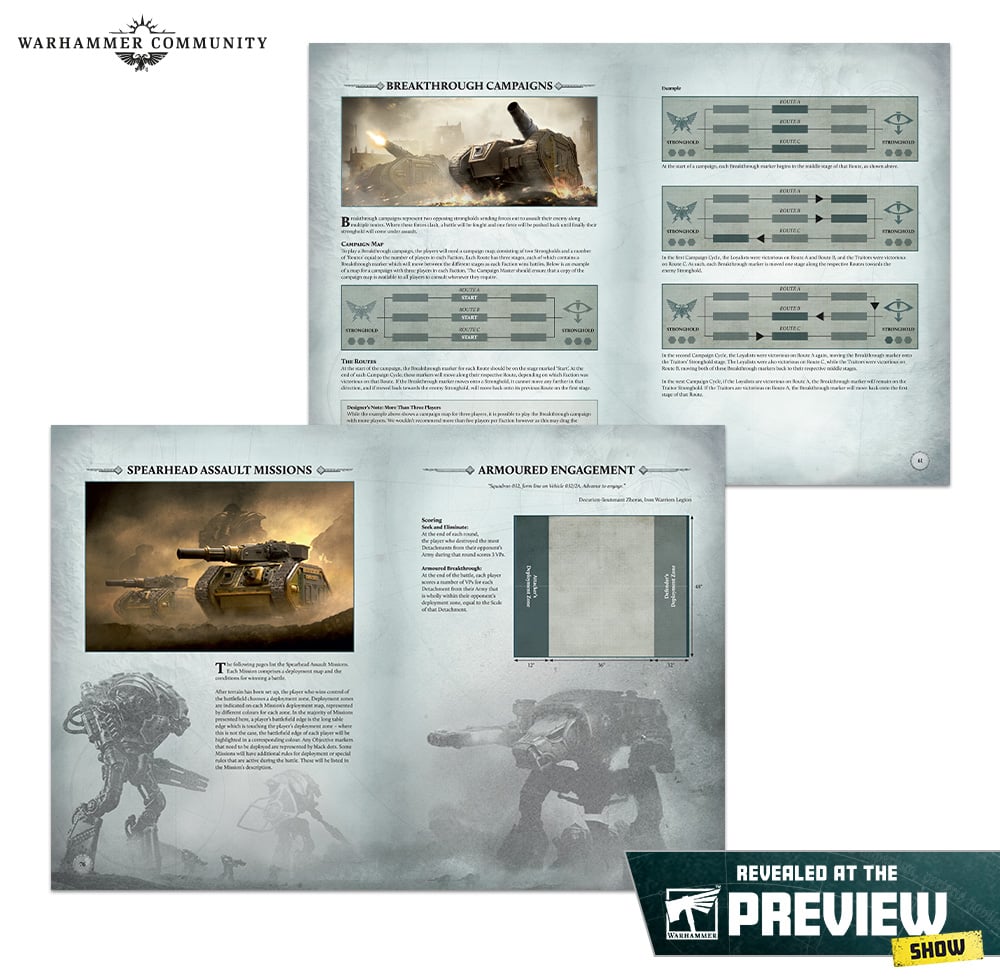
If a team manages to break through to the enemy stronghold on the majority of the routes then you fight a special battle to claim it, winning the campaign if you succeed. This is a scenario with tons of special rules, most notably including a huge fortress wall roughly across the centre of the battlefield. It sounds like a great mission to play, especially if you could get the terrain together to make it look really good.
Breakthrough Campaign: The Northern Desolation
This is a campaign representing the fighting on Tallarn relatively early in the campaign. It’s for 6 players, with three on either side, fighting to destroy either the Loyalists’ Rachab Fortress or the Traitors’ Sightless Warren. There are special rules for battles attacking these two fortresses and also for the three routes between them. All battles also use the Fog of War rules, which come later but essentially mean you can’t see more than 18″. Oh, and the fog is poisonous of course.
Campaign Rosters
These are just a roster you put together at the start of the campaign, listing all the Detachments (not necessarily made into Formations) that you can use during it. They recommend a 4000 point Roster for a 3000 point campaign, so you will have some flexibility in the Detachments you bring but not all that many. Then before each game you pick an army from the roster rather than just making one from scratch.
This is potentially a nice way to limit the benefit that players with big collections have in tailoring their army for each game. You’ll still have some choices but not infinite ones.
Victory Boons
These aren’t a big deal. Each campaign round the campaign master (if there is one) can give one player a roll on a table. This provides them with a relatively minor bonus in their next game, like a single reroll of their initiative dice or one morale reroll per turn. Personally, rather than giving this to the player who’s doing best I’d suggest giving it to players who lost their games, to give them a helping hand in the next one.
Fog of War
This is an optional rule containing a couple of other sub-optional rules, all of which can be used if agreed, or if playing the Northern Desolation Campaign above.
The core rule is Limited Visibility. You can’t shoot above 18″ except with Barrage and Heavy Barrage weapons. On top of that you can decide to use entirely secret deployment. They suggest using either a big sheet to hide what each side is doing or to put some kind of face-down notes or cards on the table to show which units are where.
Finally, Deadly Fog of War really lives up to its name. Every infantry or cavalry unit on the board has to take a saving through every end phase or take a wound. They get a +1 modifier to this and a reroll if holding a building, but even so it’s not at all a good place to be an infantry soldier. Even vehicles have to make a save or take a wound if they are damaged. Nasty!
Battle Honours
This is a way of showing that a Detachment is experienced, either in a campaign or a one-off game if both players agree.
There are tables of upgrades for each Detachment Type that can be given to one Detachment per Formation in normal games and to units that gain sufficient experience in campaigns. Each upgrade has a points cost.
There are some fun things here. Dreadnoughts might be Walking Icons, with 2+ morale and 6″ Radius Inspire, for example. Cavalry can be Forward Observers, allowing Artillery units firing Barrage to use their LoS. Titans that with Disdain for Inferiors are allowed to fire at enemy units locked in melee, though any 1s to hit are resolved against friendlies.
This seems like fun. You pay points for these upgrades even if gained through campaigns via experience, so they shouldn’t give anyone an unfair advantage.
Spearhead Assault Missions
These are advertised as a set of missions for armoured combat so we were a bit surprised to find that there are no changes to the army selection rules for them. You don’t have to take an all-tank army, and in theory you don’t have to bring any vehicles at all. Instead there are some incentives to bring tanks, mainly through the mission objectives.
There are three missions and the only real difference between them is the deployment maps. Using the standard 5×4 map, two missions use 12″ deployment side to side or end to end. The third uses whole opposite quarters with a 9″ exclusion zone in the centre. All games last five turns.
None of the scenarios use objectives for the Primary missions – though for some reason the book still includes a lot of text about how to place the objectives you don’t have! Instead you score points in three ways. First, every turn whoever has destroyed most Detachments gets 3vps, with a bonus point if any of them was still in its deployment zone in two of the missions (not end to end, for some reason). Second, at the end of the mission you get points equal to the scale of all the Detachments you get into your opponent’s deployment zone, meaning bigger stuff scores more. Third, there are also up to 15vps available for six secondary objectives and these all do require you to bring scale two or three Detachments (or to destroy them), though transports still count.
So the challenge in Spearhead is to try and get as much stuff into your opponent’s deployment zone as you can, without suffering too many casualties and falling behind on the cumulative score. Infantry detachments do score you 1vp for getting across the board but they tend to be cheap and relatively easy to destroy, so you could be causing yourself problems on the progressive points for killing Detachments. Drop Pods and Termites are a great way to get a lot of detachments into your opponent’s deployment zone, but also a great way to have those Detachments killed, losing you that turn’s kill points.
The absence of normal objective markers means infantry becomes a lot less useful. You are given a lot of good reasons to bring tanks instead of infantry, but you aren’t actually forced to. I think this works nicely to give players the option of how they’ll take on these missions.
Overall Spearhead missions present an interesting way to play Legions Imperialis, tending to encourage you to get right across the board rather than sitting back and shooting. They look quite fun.
Legions Astartes Formations
Legion Heavy Assault Spearhead
This is a highly restrictive formation of terminators, dreadnoughts and tanks. There are four compulsory support slots, two of which have to be terminators and two of which can be terminators, Contemptors or Leviathans. All the terminators have to be in Land Raiders or Spartans. Unusually, there is no HQ slot. The optional slots are totally different: two Battle Tank and two Heavy Armour detachments, plus one Air Support.
This is quite a fun detachment but a bit tricky to get together, as it requires a minimum of 8 Terminator bases and their transports. The generous selection of tanks you can take in support is useful. You could even add a Command Tank (see later on) to the formation if you want somebody to take charge of all this. Realistically though, there’s nothing here that you can’t do with the Demi-company and Armoured Company Formations, unless you want your terminators to be from a different Legion to your other guys.
Legion Subterranean Assault

This formation follows the more normal Astartes template of an HQ, two Core and one Support Detachments as your compulsory choices. Two more Core and Support Detachments can be taken as options. Any Infantry in the Formation, except those which can Deep Strike, have to buy Termites as transports. Non-infantry like Dreadnoughts just deploy normally, and indeed the example Formation they show includes a Contemptor Detachment.
You get an interesting special rule. Once the initial Termite for a Detachment has had its scatter resolved you roll a dice for every Detachment with scale 1 or 2 within 6”. On a 5+ they get the effect of Quake, halving their movement for the rest of the turn. This is obviously very unreliable but at least it’s now an example where Quake might actually do something – as currently guns that inflict Quake wear off before the enemy unit next moves.
One piece of good news is that the new Termites come in boxes of eight, meaning that building this Formation is a lot more practical, and less expensive, than a Drop Assault would be.
You should probably avoid taking Rapiers in this Formation. As Infantry they’d have to buy Termites, but as Bulky models they won’t fit inside them. Termites are a bit odd, which we’ll cover when talking about their Detachment, later.
Legions Astartes Detachments
The Legions just get four new Detachments in this book, but they bring some interesting new options.
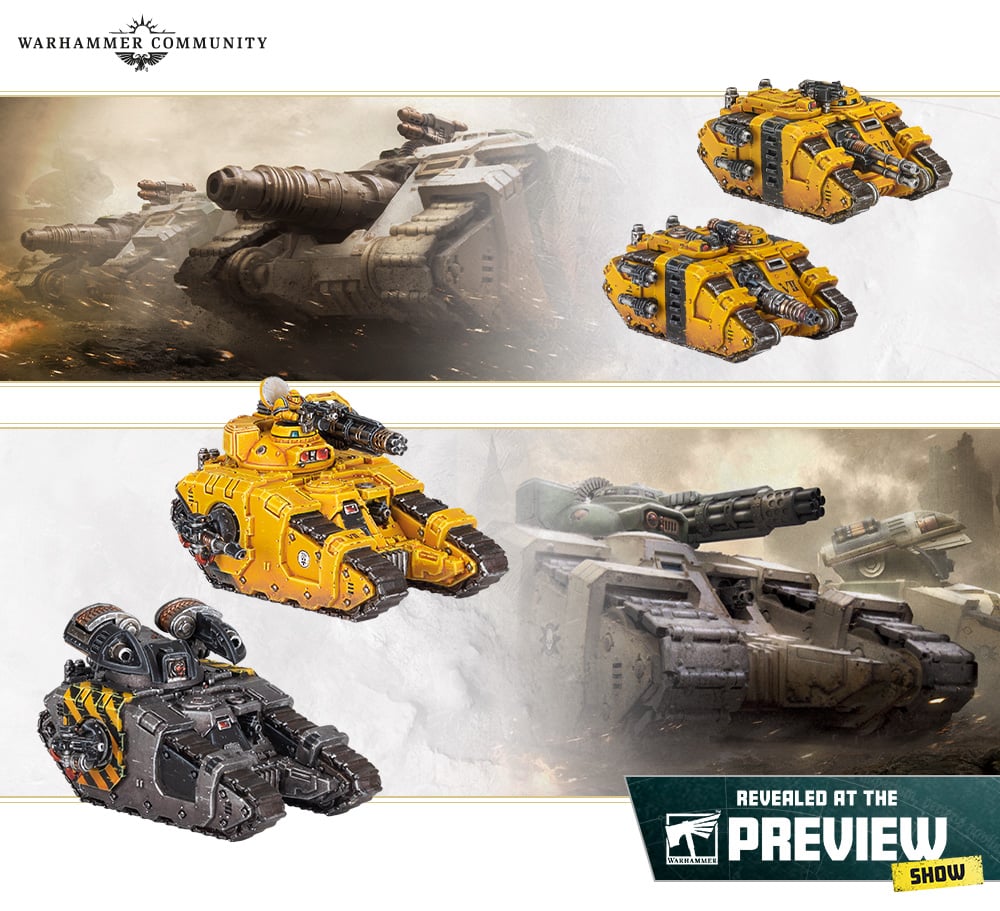
Legion Sicaran Punisher Squadron

As you’d expect, the Sicaran is great at mowing down infantry. Its Punisher Rotary Cannon has 4 shots, hitting on 4s with 12” range and -1AP. It’s Light AT so it can be used against vehicles, where its weight of fire might get the job done, and Rapid Fire, so you’ll sometimes get extra hits. This combines very nicely with the Sicaran Hull’s heavy bolters to give you a platform to ruin the day of any infantry you meet, with enough speed to hunt them down.
For some reason buying extra Punishers after the first two isn’t discounted anything like as much as the standard versions are. Perhaps they’re trying to represent their relative rarity by having you field them in small units. Small units are fine though so just do that I guess.
Legion Sicaran Arcus Squadron
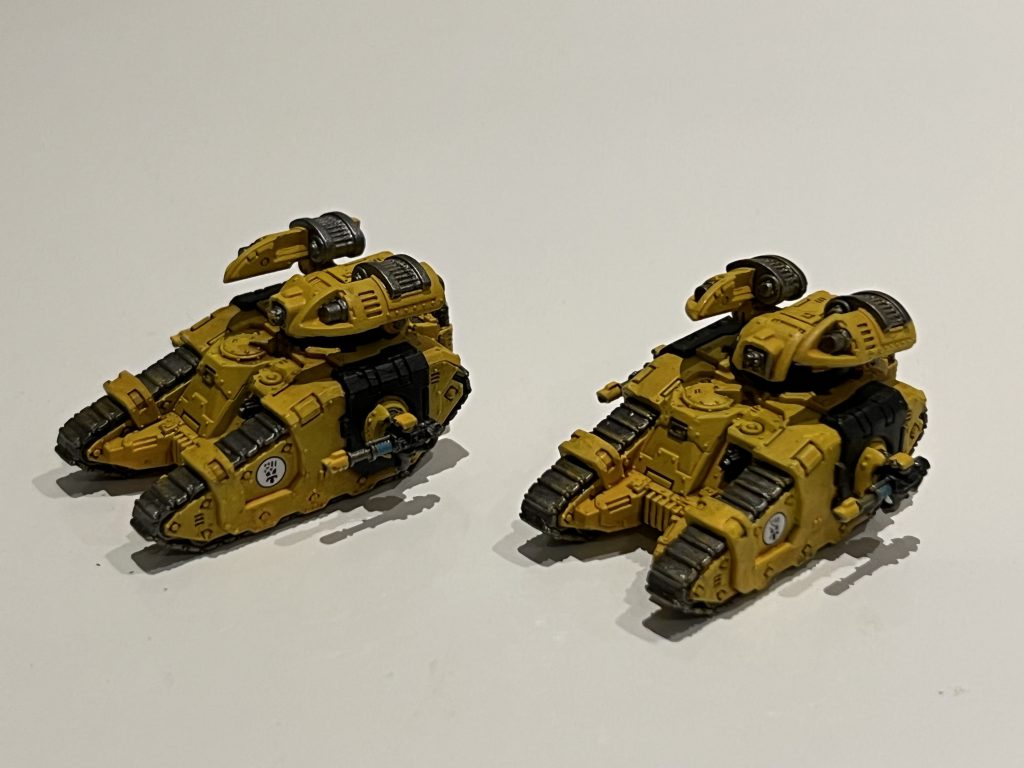
The Arcus Missile Launcher is a genuinely excellent gun for killing enemy vehicles and aircraft. It has two modes, both with two shots, AP-2 and Anti-tank. One version has 16” range, hits on a 4+ and the Ripple Fire rule, letting it reroll 1s if on First Fire. The other has 20” range, only hits on a 5+ but has Skyfire and Tracking, making it an excellent AA option. Otherwise it’s a normal Sicaran, with the usual hull heavy Bolter and sponson options.
These things seem pretty cool. They clearly outclass a standard Sicaran with plasma in the Anti-tank role and can also shoot down planes. It’s great to have an AA option that isn’t wasted if there are no enemy planes around.
Your first two Arcus in a squadron are only a bit more expensive than standard Sicarans but, as with the punisher, any extra ones are barely discounted. A Detachment of six will cost you almost as much as six Kratos, which is a bit silly. Fortunately, Detachments of two are probably enough to do their job, extending a big radius where aircraft won’t want to be and helping zap tanks now and then. I think I’d go for lascannon sponsons as these will probably hang back most of the time, and it might help if they engage enemy armour.
Legion Sabre Squadron
The first Light Armour Detachment in the game, opening up options in Demi-companies, Armoured Companies and Sky-hunter Phalanxes. Sabres have an 11” move and are Nimble, so don’t get slowed by terrain. However they only have a 4+ armour save.
The Detachment comes with four Sabres for marginally more than you’d pay for three Predators or two Sicarans. They can be armed with an Anvillus Autocannon, which is like a Predator Autocannon with an extra shot and 16” range or a Neutron Blaster, which gives you a -3AP Anti-tank shot at 12”, with the Shock Pulse rule. You also get a Heavy Bolter or Multi-melta, with the same profiles you’ve seen elsewhere. They also come with Sabre Missiles, providing an extra shot like the autocannon, though with only 12” range.
I expect we’ll see Sabres equipped either with Autocannon and Heavy Bolter for dakka or with Neutron Laser and Multi-melta for hunting tanks and bigger stuff. As with the Sicarans you get very little discount for enlarging the Detachment so I expect you’ll usually see these fielded in 4s. However, Light Armour Detachments are pretty unusual things to find in Astartes Formations, so maybe people will sometimes run the eight you get in a box all together.
Legion Termite Detachment
It took me a while to figure these things out because they’re quite strange. What you’re getting is kind of a Rhino that can Deep Strike. It only has a 5” move and its bolters get 2 dice (so 4 within 4” due to Assault) but essentially it’s a way of moving two bases of normal infantry around and occasionally abusing the rules for pinning stuff in combat.
The odd thing is that the rules of Deep-striking transport vehicles state that the passengers have to disembark as soon as the transport is “set up” – which is a term that’s never defined but I think means once all the Termites have been placed. That makes sense for Drop Pods because they can’t move but Termites can. So the sequence is that the Termites pop out of the ground, then the people inside jump out and then the Termite finishes its activation with an Advance or March move. Later on the passengers will activate and can move around how they like, perhaps even getting back in the Termite if they want to. It would have been great if the passengers could disembark during or after the Termite’s move, as they can in normal transports.
I still think Termites are reasonably good but you do have to look at them in comparison with Drop Pods, as their role is so similar. The two major differences are that Pods can arrive on Turn one and Termites can’t, but that once they do arrive the Termites can move around the battlefield and make a nuisance of themselves.
I think there’s probably a place for some small detachments in Termites. Hold them in reserve till most stuff is dead and then deploy some infantry to hold vacant objectives.
Legion Command Tanks
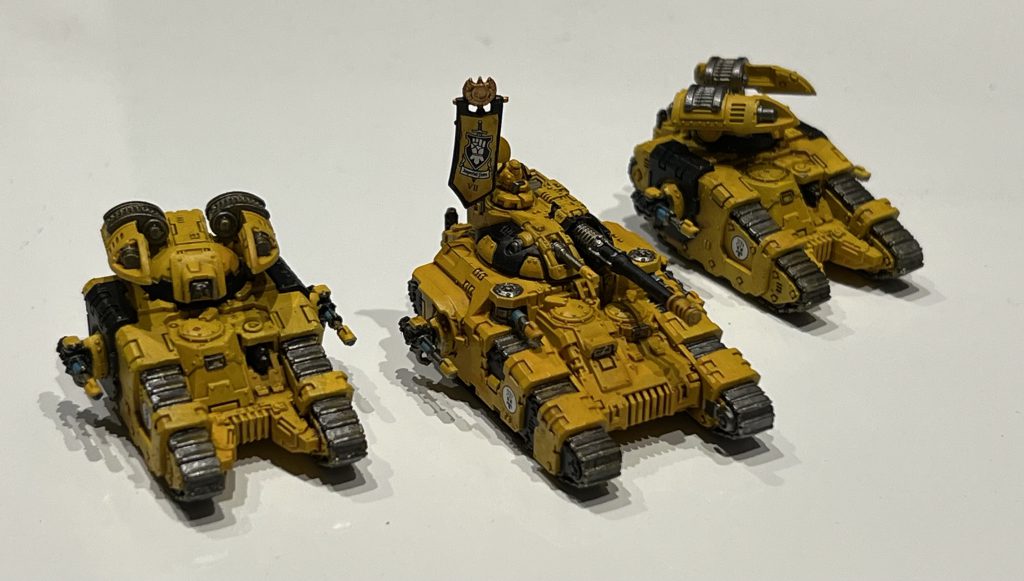
These are in their own section of the book for some reason, but essentially are new units so we’re looking at them here.
Command Tanks are Detachments of a single Predator, Sicaran or Kratos. They can have any of the current weapon options except for the Sicaran Arcus. They’re virtually identical to the standard version of the vehicle, with equal shooting but one better CAF, presumably to represent the commander swinging his sword about.
You can take one of these either to fill a Detachment’s HQ slot or to fill one of the slots a tank of its type would usually take – Battle Tank for Predators and Sicarans, for example. This latter option means you can now take more commanders than you previously had access to, including in Formations that lack an HQ slot.
The useful thing about these vehicles is that they get Commander, Inspire (8″) and Master Tactician. They also get a 6+ invulnerable save, which does nothing unless they get shot with a -4ap gun.
So overall that’s pretty nice. Now you get a leader for your tanks and a mobile bubble of inspiring and commanding things. They are all scale 2 Vehicles so they can be attached to pretty much any other vehicles you like, from Kratos to Rhinos or Sabres. You can even attach them to transports like Rhinos and Land Raiders if you like. If there are no vehicles in the formation for them to join they go around independently.
The option of having more Master Tacticians in your army is clearly quite handy. It comes at a price though, significantly adding to the cost of their unit. My first instinct was to add a commander to my unit of 6 Kratos as I had a couple of them still on sprue. On reflection I’m not sure a 450 point unit of seven Kratos is the most tactically flexible thing I could have, but it’s pretty fun. Maybe I’ll make my 8th Kratos into another commander and have it go around with a couple of Rhinos instead to see what I prefer.
Legions Astartes Formations of Legend
These are a new thing and quite fun. Each Formation of Legend is made up of specific detachments, so it tells you exactly how many models you get and what weapons they have. You have to buy an initial set of two or three Detachments and then have the option of buying a couple more. These actually come at a slight discount from their full price and you get some nice special rules as well.
For some reason these Formations tend not to have an HQ, making them a bit less flexible. I’m not sure why that is.
Iron Hands Seeker-Killer Clave Ultor
A Formation of Sicarans and Sabres, all of which get Macro-extinction Targeting Protocols for rerolls to hit against big stuff – which is quite nice. Initially you get two Squadrons of four Sicarans, one with autocannon and one with plasma, plus four Sabres with Neutron Blasters and Multi-meltas. You can buy four more Autocannon Sicarans and Sabres. They have to be Iron Hands and Loyalist.
The Sabres in this Formation benefit a lot from Macro-extinction Targeting Protocols, which will let them cause major damage to super-heavy stuff. The Sicarans aren’t really equipped for big game hunting though, so it’s less help for them. There’s actually a picture of a Sicaran Venator on the same page as this and I can’t help thinking those would be a better fit, if they existed in the game.
Iron Warriors Proioxis Macro-assault Wing
This is simple enough. You get two Terminator Detachments and their Spartan transports to start with. Optionally you can add another Terminator Detachment and a squadron of three Kratos. They have to be Iron Warriors and Traitors.
Terminators in this Formation get +2 CAF on the turn they disembark from a Spartan, which is a good buff they’ll get to use often. However you’re still looking at launching assaults with little units of four infantry stands and paying lots of points to do so.
Alpha Legion Harrow Group Arcadus
A bit of a strange one, as befits the Alpha Legion. The Core is made up of two Detachments of four Sicaran Punishers and a large eight-base Plasma Gun Support Detachment mounted, for some reason, in Land Raiders. This costs a fairly eye-watering 630 points. You can add a second massive Plasma Detachment in Land Raiders and some autocannon Sabres for 300 more, which seems a much better deal, if you own 16 plasma bases..
They all get outflank and Scout. Outflank might be somewhat redundant for Alpha Legion but Scout is nice and you can still use Mutable Tactics to let them infiltrate and the Land Raiders have Forward Deployment.
Solar Auxilia Formations
Solar Auxilia Titan Hunter Company
This is basically the old Shadowsword company, as there are three compulsory detachments, all of which are Shadowswords, and which gain Accurate on their Volcano Cannon if given First Fire orders.
This deals with the major feel bad of Shadowswords from Space Marine 2nd edition to now, rolling 1s on your Volcano Cannon.
If you do want to go all in with Shadowswords and get two boxes, then this is the formation to field them in, and the 4th hull can be mixed in to your Super Heavy Company or Armoured Company formations.
Leman Russ Spearhead
Essentially an Armoured company where the compulsory elements are all Leman Russ hulls. The optional detachments (Light Armour, Battle Tank, Heavy Armour, Air Support) let you pack even more tanks in, but there are no special rules to benefit from, and it’s essentially the old Leman Russ Armoured Company from 2nd edition.
Leman Russes as tanks range from mediocre to excellent depending on the type, and I’ll go into a lot more detail on this in the detachment section, but losing the compulsory Heavy Armour slot means you can go with a fairly fast formation that isn’t tied to a slower super heavy tank.
Solar Auxilia Detachments
Auxilia Shadowsword Squadron
The Shadowsword comes to Legions Imperialis, and it’s got the same feel as in Space Marine 2nd edition.
Mounting a Volcano Cannon with a 70” range, you want to sit this at the back (though under your tarantula anti-air umbrella and with some screening units) and pop enemy titans and super heavy units. -4 AP and Engine Killer (2) mean if you’re firing at something without Void shields it’s in trouble, but it suffers from the same vulnerabilities as the other auxilia super heavy units, vulnerability to anti-tank weapons and infantry/fast attack assault.
CAF +2 is fine against one infantry stand, but if there are three then you will get swarmed. 6 dice of point defence heavy bolters help, but I’d strongly advise against trying to clear an urban area with garrisoned infantry ready to charge out at you with these.
Auxilia Stormsword Squadron
A Shadowsword hull swapping the volcano cannon for a slightly worse demolisher cannon with a 30” range. A 30” range is nice on a weapon with Ignores Cover and Demolisher, but it’s still a single dice weapon and even if the price has dropped to 100 points a model, there are a variety of tanks armed with Demolisher cannons available that are a much more disposable way of knocking down buildings or winkling enemies out of them.
I strongly feel you’re better off with Shadowswords.
Auxilia Stormblade Squadron
A Shadowsword with a Plasma Blastgun this time, which comes at 120 points a model. While the Plasma Blastgun is reasonable for engaging armour vehicles, and the range of it is 20” where you will also get to use the lascannon turret dice, I feel you’re going to get more value taking Baneblades in the same role of closely supporting infantry.
Leman Russes
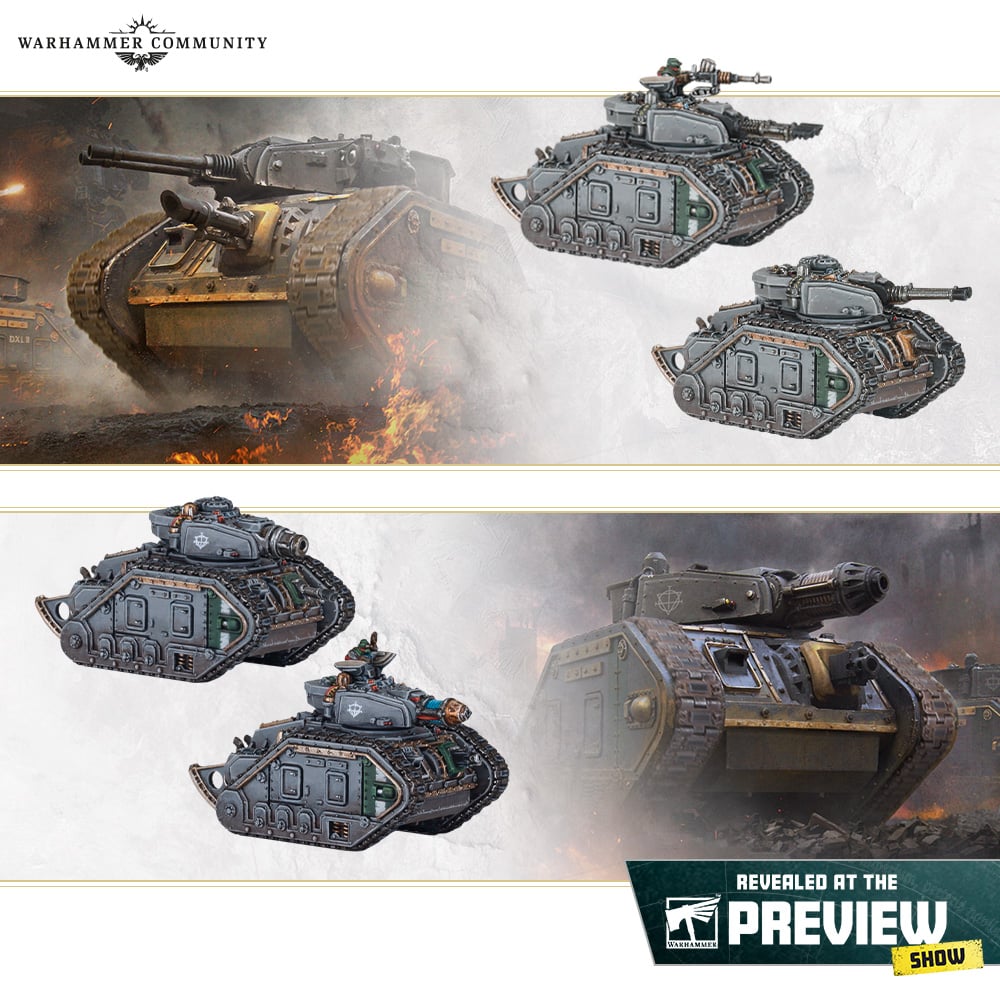
This supplement adds four more Leman Russ types, all costing 175 points. This is worth discussing from a design point of view, because they shouldn’t all cost 175 points as it means you have six different turret options that the game treats as equally valuable when they clearly aren’t, and having some variation in terms of points would encourage people to experiment and pick cheaper or more expensive options in their army building.
Here’s a table of the damage outputs of the different Russ turrets (the secondary lascannon/heavy bolter are coloured grey so you can see what they add).
 I’ve included all the turrets, so you can see performance across all types. I’ve also included the hull weapon options, so that you can see what they add to damage output.
I’ve included all the turrets, so you can see performance across all types. I’ve also included the hull weapon options, so that you can see what they add to damage output.
The flat out worst turret is the Battlecannon, with the lowest average damage score, the lowest score against walkers and the lowest score against vehicles. It only beats the Vanquisher turret, the best anti-tank turret, against infantry.
Beating it but by no means that much better is the Annihilator, with Accurate to increase the number of hits it scores.
Of the two anti-infantry turrets the Executioner and Exterminator have exactly the same score, but the Exterminator is better for two reasons. One is the additional 4” of range, and that 4” means you can sit out of range of Light AT weapons like plasma guns or multi-lasers and not be shot back. As most infantry move 5”, then a 16” range also puts you out of range of being charged.
The other is variance. Using simple calculations as the table above does, two dice needing 4+ will on average score 1 hit and 3 dice needing 5+ will on average get the same. This is, however, something of a simplification.
However there is a 25% chance that the two dice needing 4+ will score no hits, and a 25% chance you will get two hits.
For three dice needing 5+ you have a 70.3% chance of at least one hit, a 25.9% chance of two hits and a 3.7% chance of three hits. The averages are about the same, but there is a greater variance. It turns into how lucky do you feel.
Of the two anti-infantry tanks I recommend the Exterminator, and pairing with a hull heavy bolter has you, on average, killing an infantry stand in the open per tank.
The Annihilator is in an odd position where despite being a lascannon armed tank it’s sort of an all rounder. Accurate on the turret increasing the number of hits you generate means it is as good as the Demolisher for targeting infantry and walkers, as more hits compensates for not removing the saving throw of the target, but it’s not as good at anti-tank as the Vanquisher, though it has decent range.
This leaves the Demolisher and the Vanquisher, which are good for different reasons.
The Vanquisher can stand off well out of range of things like lascannons and put armour-piercing shells in the hulls of Predators or titans or whatever, and Armourbane forcing your opponent to reroll successful saves is super annoying (to them). In terms of value for points, it’s the best long-ranged anti-armour available.
The Demolisher however is the best all rounder. While the 12” range is fairly short, it’s great against every target with AP -3, Demolisher and Ignores Cover, and is a great infantry support tank. With the Demolisher a 12” range gun the temptation is to pair it with a hull heavy bolter, but I’d look at whether you are putting them in a formation that lacks anti-tank, as lascannons aren’t anything to sniff at.
Clearly a battlecannon Russ isn’t as good as a Demolisher or Vanquisher Russ, and not having some variance in points (so a Battlecannon Russ squadron costing 160 points for example, 3.75 points less per model) means that some variants simply won’t be taken, or the player building their minis how they like will end up at a disadvantage to a player that works out the math. Games shouldn’t be designed like that.
Leman Russes occupy the Battle Tank slot, and it’s worth not forgetting about the Battle Tank slot on the Pioneer company as a way of giving a squadron Forward Deployment, though it’s competing with the Malcador Infernus for this.
Solar Auxilia Formations of Legend
Tallarn Reborn Carmine Ambush Tercio
A Loyalist tank formation that gets Forward Deploy and Scout, so a free move at the start of the game and +1 cover save.
However you are tied to taking a Vanquisher + lascannon squadron and tank commander (great, cool, good), an Annihilator + lascannon squadron (ok, nice to have, hmmm) and an Executioner + lascannon squadron (meh, would have preferred heavy bolter) for 515 points (so a 20 point discount). You can add two Aethon Heavy Sentinel squadrons of 4 models each for 100 points (another 20 point discount).
I actually like it, the Aethons can make better use of Scout than the tanks, and a free move at the start of the game is always nice to have. The Aethons also add a lot of anti-infantry/Light AT punch to the formation so I wouldn’t leave home without them.
Galibed Oathsworn Thyreos Siege Breaker Company
A traitor tank formation that lets 3 Stormswords bodyguard 4 Medusas and 4 Basilisks for 550 points, and add another 3 Stormswords and 4 Basilisks for 400 points. You get a 50 point discount on the compulsory units, and a 20 point discount on the additional units, but the Basilisks don’t get the artillery company rule. Also note there is no tank commander so you need to dedicate a command unit to following this formation around.
However I don’t like it for the following reasons:
- Every unit has a different range bracket they engage in, from Medusas with a 12” range, Stormswords with 30” and Basilisks with 90”.
- The formation needs screening and is very vulnerable to assault – the highest CAF is the Stormsword with +2, you are just asking to get mugged by Scimitars, Outriders or mechanised infantry.
- Everything moves 6” so it’s not a fast formation.
- Everything wants to go on different orders (Basilisks on First Fire, Medusas on March till they get close to something) and you’re Auxilia so you need to keep a command unit within range or everything defaults to Assault Orders, which isn’t necessarily bad but does add to the slow trundling across the board.
Having Stormswords get allocated hits if they’re within 2” of the Basilisks or Medusas is just puzzling, as if someone creates a 3 model Super Heavy squadron to slowly trundle across the board then I’m dropping hellfire on the Super Heavy squadron, as all the point defense is in it and once one or two are stripped away then the rest of the formation are slow, 1 dice tanks with +0 CAF that are easy meat for pretty much anything.
This formation is bad. I get the idea, and if it was, say, a Stormblade squadron (with a command tank) and two Medusa squadrons with Bunker Buster (double AP against buildings) as the formation special rule then you’d have a formation people would want to take with a clear purpose (sieging fortifications) and a rule reflecting that. Stormblades bodyguarding Basilisks and Medusas is just not a very exciting or logical idea.
Conclusion
Phew, there’s really a lot of content in this book!
It’s nice to see the rosters fleshed out a bit, but perhaps surprising that both Astartes and Solar Auxilia still lack certain key units. Astartes could really do with some artillery and also Vindicators to take out buildings. The Solar Auxilia now have those roles nicely covered but no Light Armour. It’s also a shame Astartes only have one type of Heavy Armour (the excellent Kratos), as this is a compulsory slot in their Armoured Companies. If you’re bringing lots of the new tanks you’re going to need some Kratos to babysit them, for now.
My only reservation with this book is that so much of this content is based around campaigns and, at least in my area, these don’t tend to be played all that often. Actually when I have gone to campaign events the organisers have tended to organise their own rules for it, and with good reason. The Breakthrough campaigns in this book don’t run for a set number of games, making them unsuited for a day or weekend where you have a time limit. They’re a nice concept though and you could quite easily adapt them, perhaps by having whichever side was further down the track after the penultimate game launch a stronghold assault in the last one.
If you aren’t using the campaign section then this book requires you to spend quite a lot to get hold of the rules for a relatively small number of new models. It’s a little annoying to have to buy multiple campaign books just to get the rules for all the units in your army. You’ll probably end up heading to your games carrying multiple different books. I hope I’m able to remember which book has the rules for each unit in, or else I’ll be flicking through loads of them all the time.
Have any questions or feedback? Drop us a note in the comments below or email us at contact@goonhammer.com. Want articles like this linked in your inbox every Monday morning? Sign up for our newsletter. And don’t forget that you can support us on Patreon for backer rewards like early video content, Administratum access, an ad-free experience on our website and more.
